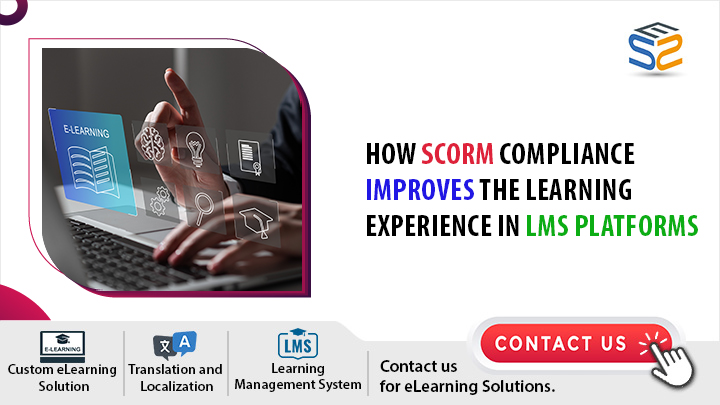How SCORM Compliance Improves the Learning Experience in LMS Platforms
The rise of eLearning has transformed how instructional content is delivered and received. Learning Management Systems (LMS) are central to this shift, providing a unified platform for developing, delivering, and monitoring online training programs. SCORM compliance is a key factor that enhances both the functionality and user experience of LMS platforms.
Understanding SCORM Compliance
SCORM (Sharable Content Object Reference Model) is a set of technological standards designed for creating and delivering digital learning content. It ensures that eLearning courses and content can be easily shared and integrated across different LMS platforms. SCORM compliance offers several benefits, including improved content interoperability and precise tracking and reporting.
Key Principles of SCORM:
Content Interoperability: SCORM-compliant content can be used across various LMS platforms without modification. This means that once content is developed, it can be delivered to any SCORM-compliant LMS.
Content Reusability: SCORM allows for the creation of modular learning items that can be reused in multiple courses or contexts. This reduces the need to recreate content and enhances course development efficiency.
Content Sequencing: SCORM provides guidelines for structuring and sequencing instructional modules, ensuring that learners encounter the material in a logical and systematic manner.
Tracking and Reporting: SCORM-compliant content supports extensive tracking of learner progress and performance, including completion rates, quiz scores, and time spent on each module.
Benefits of SCORM Compliance in LMS Platforms
Enhanced Compatibility: SCORM compliance ensures interoperability across different LMS platforms, allowing eLearning content to be imported and used seamlessly across various systems. This compatibility alleviates concerns about content functioning on new or different LMS platforms and simplifies the process of switching LMS providers.
Improved Content Reusability: SCORM enables the creation of reusable learning objects, which can be single modules or components used across multiple courses. This modular approach saves time and costs, facilitates updates, and ensures consistency across training programs.
Detailed Tracking and Reporting: SCORM compliance provides robust tracking and reporting capabilities, allowing LMS platforms to capture a range of learner performance data. This data helps instructors and administrators gain insights into learner progress, identify areas needing additional support, and make data-driven improvements to training programs.
Scalability and Flexibility: SCORM compliance supports scalability and flexibility in delivering eLearning content. As organizations grow and their training needs evolve, SCORM-compliant content can be easily updated and expanded to meet new demands. The modular nature of SCORM allows for the straightforward incorporation of new content and modifications into existing courses.
Cost-Efficiency: Utilizing SCORM-compliant content can lead to cost savings for organizations. The ability to reuse content and minimize the need for content adaptation across different LMS platforms helps reduce development and maintenance costs. Additionally, SCORM compliance can streamline the implementation and management of training programs, allowing organizations to allocate resources more effectively.
Enhanced User Engagement: SCORM-compliant content often includes interactive elements such as quizzes, simulations, and activities that enhance user engagement and improve the learning experience. Engaging content not only promotes learner satisfaction and motivation but also increases the likelihood of course completion and application of knowledge in the workplace.
Implementing SCORM Compliance in Your LMS
To maximize the benefits of SCORM compliance, organizations should consider the following steps:
- Choose a SCORM-Compliant LMS: Ensure that the LMS you select supports SCORM standards. While most modern LMS platforms are SCORM-compliant, it’s essential to verify this feature to avoid compatibility issues.
- Develop SCORM-Compliant Content: Work with eLearning developers experienced in creating SCORM-compliant content. This ensures that your courses adhere to SCORM standards and are compatible with your LMS.
- Test Content Thoroughly: Regularly review and update SCORM-compliant content to maintain its relevance and effectiveness. Monitor learner feedback and performance data to make necessary adjustments.
- Monitor and Update Content Regularly: Continuously review and update SCORM-compliant content to ensure it remains current and effective. Utilize learner feedback and performance metrics to drive improvements.
SCORM compliance is essential for optimizing eLearning and LMS platforms, enhancing content compatibility, reusability, and seamless integration. By adhering to SCORM standards, organizations can improve content interoperability, streamline management, and deliver a consistent learning experience. The benefits of SCORM compliance include enhanced tracking, cost savings, and future-proofing.
Frequently Asked Questions (FAQs)
Q1. What is SCORM?
A. SCORM stands for Sharable Content Object Reference Model. It is a set of technological standards for eLearning content that ensures compatibility and interoperability across various Learning Management Systems (LMS).
Q2. Why is SCORM compliance important?
A. SCORM compliance is important because it ensures that eLearning content can be shared and used across multiple LMS platforms without the need for modifications. It also promotes content reusability, detailed tracking, and consistent learner experiences.
Q3. How does SCORM improve content reusability?
A. SCORM allows for the creation of modular learning objects that can be reused in different courses or contexts. This modular approach reduces the need to recreate content and enhances efficiency in course development.
Q4. What are the benefits of SCORM compliance for tracking and reporting?
A. SCORM compliance provides comprehensive tracking and reporting capabilities, including metrics on learner progress, quiz scores, and time spent on each module. This data helps instructors and administrators assess training effectiveness and make data-driven adjustments.
Q5. Can SCORM-compliant content be used across different LMS platforms?
A. Yes, SCORM-compliant content is designed to be compatible with various LMS platforms. This ensures that once content is created, it can be deployed and used across different systems without requiring modifications.
Q6. How can organizations ensure their content is SCORM-compliant?
A. Organizations should collaborate with eLearning developers who have experience creating SCORM-compliant content. Additionally, they should choose a SCORM-compliant LMS and thoroughly test it to ensure compatibility.
Q7. Is SCORM compliance future-proof?
A. SCORM is designed to adapt to new technologies and standards, making it a future-proof solution for eLearning content. This ensures that SCORM-compliant content remains relevant and compatible with future advancements.




